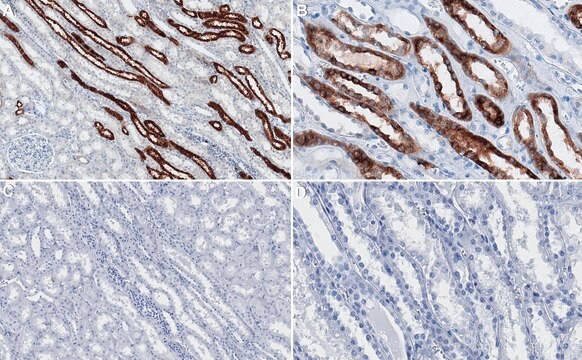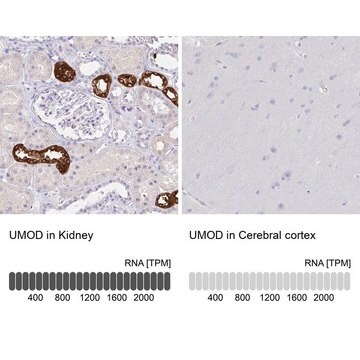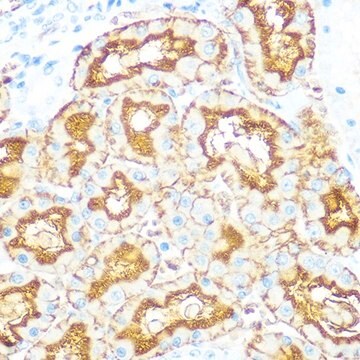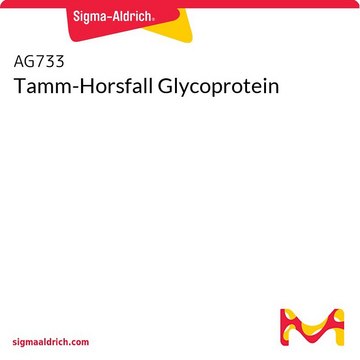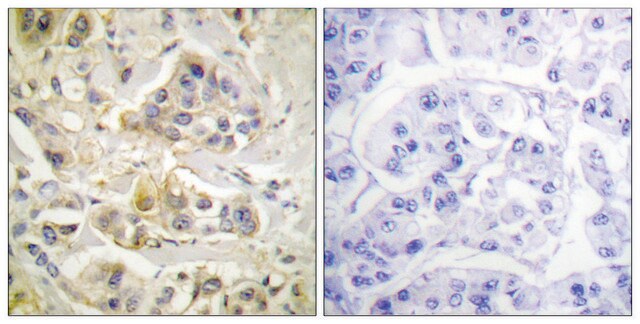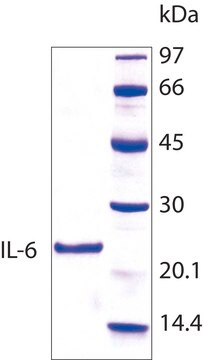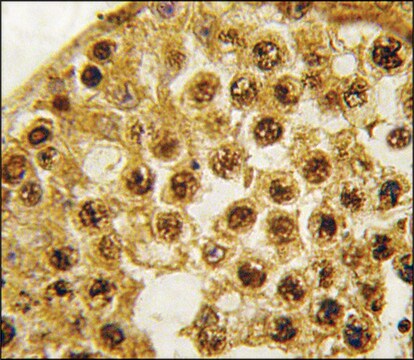추천 제품
생물학적 소스
mouse
결합
unconjugated
항체 형태
IgG fraction of antiserum
항체 생산 유형
primary antibodies
클론
polyclonal
양식
buffered aqueous solution
종 반응성
human
기술
immunohistochemistry (formalin-fixed, paraffin-embedded sections): suitable
indirect immunofluorescence: suitable
western blot: 1 μg/mL
UniProt 수납 번호
배송 상태
dry ice
저장 온도
−20°C
타겟 번역 후 변형
unmodified
유전자 정보
human ... UMOD(7369)
관련 카테고리
일반 설명
This gene encodes uromodulin, the most abundant protein in normal urine. Its excretion in urine follows proteolytic cleavage of the ectodomain of its glycosyl phosphatidylinosital-anchored counterpart that is situated on the luminal cell surface of the loop of Henle. Uromodulin may act as a constitutive inhibitor of calcium crystallization in renal fluids. Excretion of uromodulin in urine may provide defense against urinary tract infections caused by uropathogenic bacteria. Defects in this gene are associated with the autosomal dominant renal disorders medullary cystic kidney disease-2 (MCKD2) and familial juvenile hyperuricemic nephropathy (FJHN). These disorders are characterized by juvenile onset of hyperuricemia, gout, and progressive renal failure. While several transcript variants may exist for this gene, the full-length natures of only two have been described to date. These two represent the major variants of this gene and encode the same isoform. (provided by RefSeq)
면역원
UMOD (AAH35975, 1 a.a. ~ 611 a.a) full-length human protein.
Sequence
MGQPSLTWMLMVVVASWFITTAATDTSEARWCSECHSNATCTEDEAVTTCTCQEGFTGDGLTCVDLDECAIPGAHNCSANSSCVNTPGSFSCVCPEGFRLSPGLGCTDVDECAEPGLSHCHALATCVNVVGSYLCVCPAGYRGDGWHCECSPGSCGPGLDCVPEGDALVCADPCQAHRTLDEYWRSTEYGEGYACDTDLRGWYRPHPSSDEGIVSRKACAHWSGHCCLWDASVQVKACAGGYYVYNLTAPPECHLAYCTDPSSVEGTCEECSIDEDCKSNNGRWHCQCKQDFNITDISLLEHRLECGANDMKVSLGKCQLKSLGFDKVFMYLSDSRCSGFNDRDNRDWVSVVTPARDGPCGTVLTRNETHATYSNTLYLADEIIIRDLNIKINFACSYPLDMKVSLKTALQPMVSALNIRVGGTGMFTVRMALFQTPSYTQPYQGSSVTLSTEAFLYVGTMLDGGDLSRFALLMTNCYATPSSNATDPLKYFIIQDRCPHTRDSTIQVVENGESSQGRFSVQMFRFAGNYDLVYLHCEVYLCDTMNEKCKPTCSGTRFRSGSVIDQSRVLNLGPITRKGVQATVSRAFSSLGLLKVWLPLLLSATLTLTFQ
Sequence
MGQPSLTWMLMVVVASWFITTAATDTSEARWCSECHSNATCTEDEAVTTCTCQEGFTGDGLTCVDLDECAIPGAHNCSANSSCVNTPGSFSCVCPEGFRLSPGLGCTDVDECAEPGLSHCHALATCVNVVGSYLCVCPAGYRGDGWHCECSPGSCGPGLDCVPEGDALVCADPCQAHRTLDEYWRSTEYGEGYACDTDLRGWYRPHPSSDEGIVSRKACAHWSGHCCLWDASVQVKACAGGYYVYNLTAPPECHLAYCTDPSSVEGTCEECSIDEDCKSNNGRWHCQCKQDFNITDISLLEHRLECGANDMKVSLGKCQLKSLGFDKVFMYLSDSRCSGFNDRDNRDWVSVVTPARDGPCGTVLTRNETHATYSNTLYLADEIIIRDLNIKINFACSYPLDMKVSLKTALQPMVSALNIRVGGTGMFTVRMALFQTPSYTQPYQGSSVTLSTEAFLYVGTMLDGGDLSRFALLMTNCYATPSSNATDPLKYFIIQDRCPHTRDSTIQVVENGESSQGRFSVQMFRFAGNYDLVYLHCEVYLCDTMNEKCKPTCSGTRFRSGSVIDQSRVLNLGPITRKGVQATVSRAFSSLGLLKVWLPLLLSATLTLTFQ
물리적 형태
Solution in phosphate buffered saline, pH 7.4
면책조항
Unless otherwise stated in our catalog or other company documentation accompanying the product(s), our products are intended for research use only and are not to be used for any other purpose, which includes but is not limited to, unauthorized commercial uses, in vitro diagnostic uses, ex vivo or in vivo therapeutic uses or any type of consumption or application to humans or animals.
적합한 제품을 찾을 수 없으신가요?
당사의 제품 선택기 도구.을(를) 시도해 보세요.
Storage Class Code
10 - Combustible liquids
Flash Point (°F)
Not applicable
Flash Point (°C)
Not applicable
가장 최신 버전 중 하나를 선택하세요:
Qizheng Wang et al.
Frontiers in genetics, 12, 632810-632810 (2021-03-02)
The use of differentiating human induced pluripotent stem cells (hiPSCs) in mini-tissue organoids provides an invaluable resource for regenerative medicine applications, particularly in the field of disease modeling. However, most studies using a kidney organoid model, focused solely on the
자사의 과학자팀은 생명 과학, 재료 과학, 화학 합성, 크로마토그래피, 분석 및 기타 많은 영역을 포함한 모든 과학 분야에 경험이 있습니다..
고객지원팀으로 연락바랍니다.
